|
 Recently completed Stealth Bird Netting Project
#3216208
Recently completed Stealth Bird Netting Project
#3216208
07/07/12 09:14 AM
07/07/12 09:14 AM
|
Joined: Dec 2006
SW Pa
Bob Jameson
 OP
OP
trapper
|
 OP
OP
trapper
Joined: Dec 2006
SW Pa
|
Had a call last week from a concerned older retired female teacher with a complaint of an animal chewing wood from the interior overhead of a boat storage pavilion type building. At first I was just a little thrown off base by her description and the location of the problem. Then after a few minutes of talking we determined it wasnt wood frass material like saw dust, but strips of splintered wood lying all over the cement floor and on the now empty boat trailor pavilion. From the description I now could determine the most likely scenario without seeing the problem. I suggested it was a carpenter bee infestation initially. Which most likely has been going on for many years as she never had any treatments for that problem in the buildings history. So, now that the bees have chewed many galleries and successfully laid their eggs and sealed off each of their egg compartments with some nectar honey bread the larvae will develop into fat little grubs or juvenile carpenter bees depending upon how long they have been developing as to what stage of development they were prior to the extraction by the woodpeckers. I asked if she had heard any woodpecker drilling activity over the last few months she said not really. Then asked if she has seen any woodpeckers near the house over the last few months. She said she had seen some pileated woodpeckers near the boat storage area. Now we had our answer, much to her disbelief that a bird could cause such significant damage to her trusses and overhead joists. Here are some photos of some of the damaged areas and the completed stealth netting installation.The bird damage will now stop but we also treated her, after the fact, for the carpenter bees ( all of drilling is over for the most part by this time of year ) and will also treat her for carpenter bees each spring now to prevent further carpenter bee infestation.These destructive bees need to be treated annually for the best control. I also included a cross section of a carpenter bee gallery for all to see if you have never seen what a gallery looks like from the interior. They can be an extremely damaging insect resulting in extreme wood integrity loss as is indicated from the photos.100 times worse over time then termite damage if left untreated. 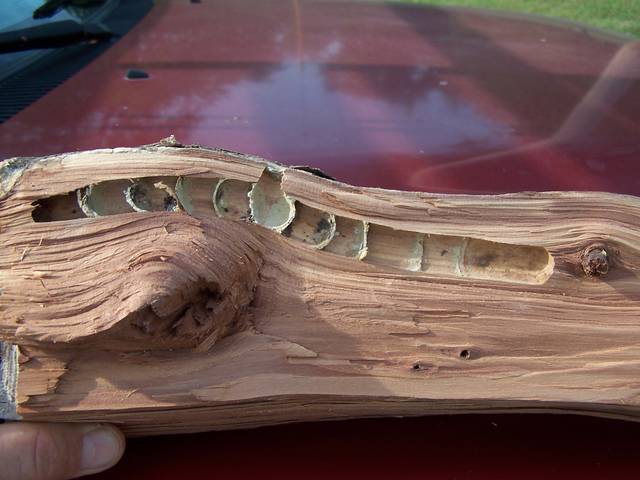 This is the cross cut section of an average carpenter bee gallery from a piece of cedar tree trunk with brood chamber sections shown. So much for cedar wood being noted as being a pest proof natural wood product.Another wives tale proved wrong.A single egg is laid in each capped chamber with stored food for nourishment for each larvae to consume until mature to hatch and subsequently emerge as an adult. 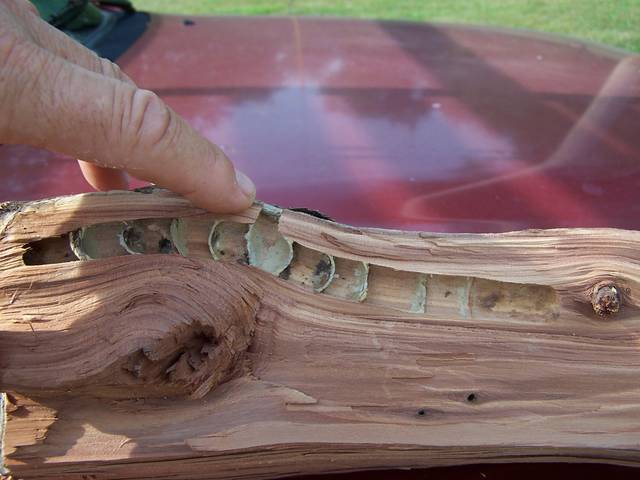 The original drill point of entry is noted here, then subsequent drilling is done perpendicular to the entry hole in opposite directions. Over several years of use the chamber networks become vast and several such galleries are drilled to accomadate several female brood chambers. A condo of sorts.All emerging from the initial drill point on the surface of the wood as they mature. Regardless of the egg laying sequence each egg will only emerge in the order which allows the last layed egg to emerge first allowing for obstruction free emerging.If not, the first laid egg, which is the furthest egg from the emergest hole would not be able to emerge without chewing thru each preceeding brood contained wall.  Typically you wont see mud or saw dust masticated entry barriers formed in such a way until late fall. This gallery capping behavior protects the gallery and its occupants from cold air flow and potential freezing rain and snow etc over the winter months. For our local summer conditions the original entry point to the gallery is not commonly seen. The original points of drilling are usually left open for easy hatching and needed air flow to take place.However the interior chambers are all still sealed between individual egg chambers. Some woodpecker damage in the boat storage pavilion. 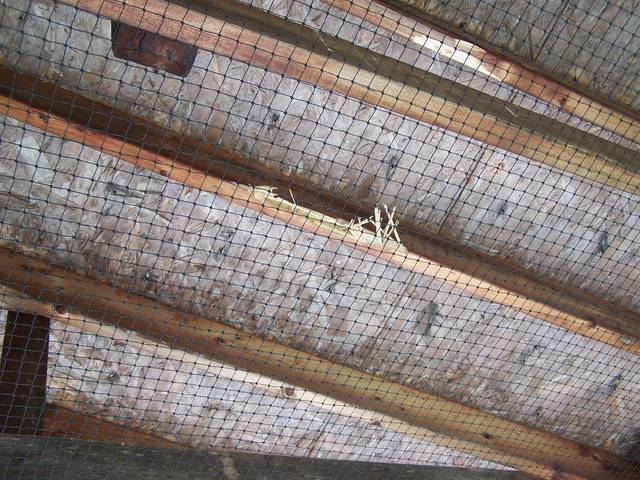 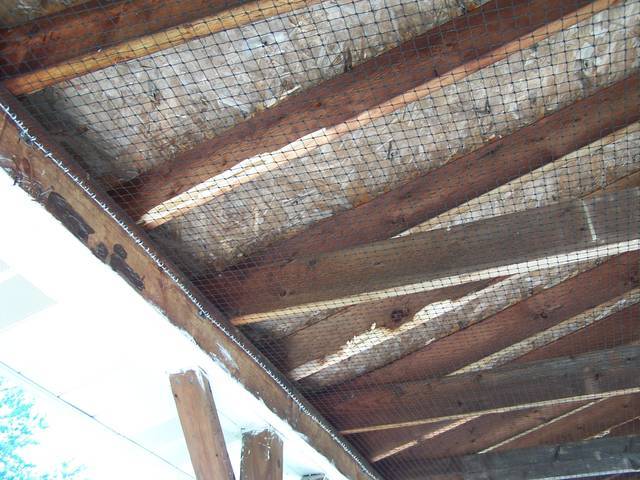 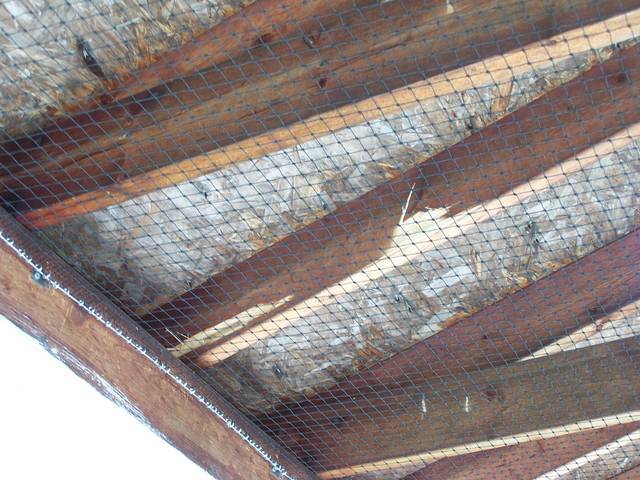 Here are a few photos of the netting completed and corner attachments of the grid cable. 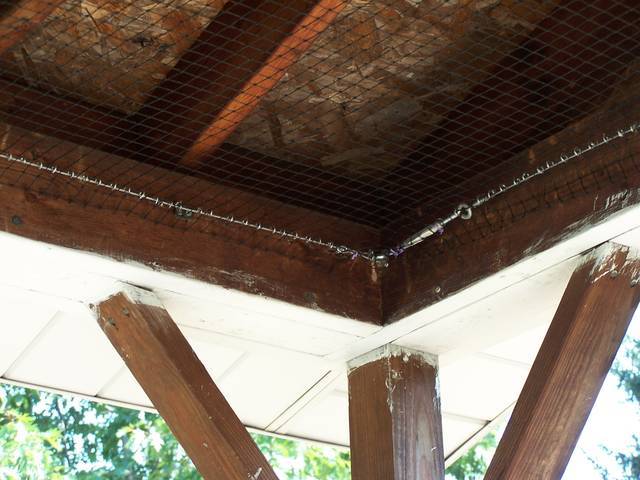 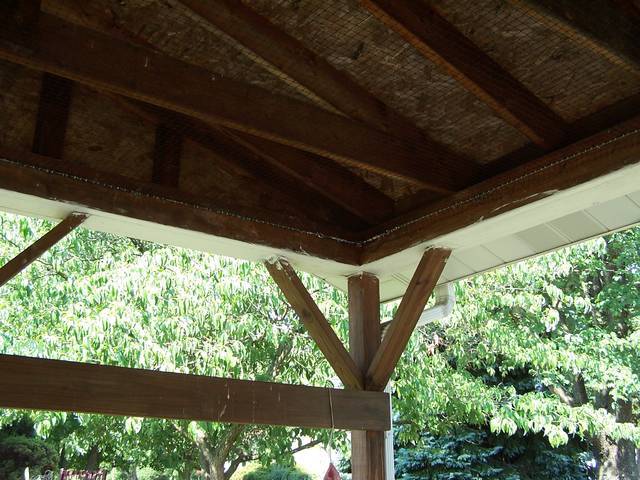 
|
|
|
 Re: Recently completed Stealth Bird Netting Project
[Re: Bob Jameson]
#3216547
Re: Recently completed Stealth Bird Netting Project
[Re: Bob Jameson]
#3216547
07/07/12 02:24 PM
07/07/12 02:24 PM
|
Joined: Dec 2006
St. Louis Co, Mo
BigBob

trapper
|

trapper
Joined: Dec 2006
St. Louis Co, Mo
|
In my experience Carpenter Bee's leave more like a course to fine sawdust, and my first thought for the splintered leavings would be a Squirrel, but not so much from the bottom side like those pics. They are especially rough on Western Red Cedar construction.
Excellent pic's of the Bee nest, never thought to disect one before.
Every kid needs a Dog and a Curmudgeon.
Remember Bowe Bergdahl, the traitor.
Beware! Jill Pudlewski, Ron Oates and Keven Begesse are liars and thiefs!
|
|
|
 Re: Recently completed Stealth Bird Netting Project
[Re: Bob Jameson]
#3216759
Re: Recently completed Stealth Bird Netting Project
[Re: Bob Jameson]
#3216759
07/07/12 04:49 PM
07/07/12 04:49 PM
|
Joined: Feb 2007
AR
22mag

trapper
|

trapper
Joined: Feb 2007
AR
|
|
|
|
 Re: Recently completed Stealth Bird Netting Project
[Re: Peskycritter]
#3217532
Re: Recently completed Stealth Bird Netting Project
[Re: Peskycritter]
#3217532
07/08/12 09:36 AM
07/08/12 09:36 AM
|
Joined: Jun 2009
Dayton, OH
trapper4hire

trapper
|

trapper
Joined: Jun 2009
Dayton, OH
|
It's not like that up here the woodpeckers I whack are nesting in the walls , there's two holes one real small one the male roast in and a bigger one for the female , the male flys in at dusk then calls to the female . One nice thing about Michigan there's only one protected woodpecker so all others are open season if there causing damage . No permit needed . Pestcontrol guys around here just sign people up for a 1 year contract . They come out once a month and spray . Doesn't seem very healthy or green . But that's how they do it . I know there not getting there spray up inside to the root of the problem . Wonder if they call that job security . What's the active ingredient in Demand CS "Woodpeckers are classified as migratory, nongame birds and are protected by the Federal Migratory Bird Treaty Act. The red-cockaded woodpecker (Picoides borealis) and the ivory-billed woodpecker (Campephilus principalis) are on the Endangered Species list and are thus offered full protection. When warranted, woodpeckers other than the endangered species can be killed but only under a permit issued by the Law Enforcement Division of the US Fish and Wildlife Service upon recommendation of USDA-APHIS-Wildlife Services personnel. Generally, there must be a good case to justify issuance of a permit." The Black Backed Woodpecker may be the only STATE endangerred woodpecker in Michigan. But it seems to me that all woodpeckers are FEDERALLY protected. Any wood pecker job I have ever done (that required "whacking" as it was called earlier) has required a FEDERAL permit, regardless of species. If I am misinformed would someone KNOWLEDGEABLE please enlighten me.
Last edited by trapper4hire; 07/08/12 09:50 AM.
|
|
|
 Re: Recently completed Stealth Bird Netting Project
[Re: trapper4hire]
#3217788
Re: Recently completed Stealth Bird Netting Project
[Re: trapper4hire]
#3217788
07/08/12 12:40 PM
07/08/12 12:40 PM
|
Joined: Dec 2006
Lower Alabama (Daleville)
LAtrapper

"Professor"
|

"Professor"
Joined: Dec 2006
Lower Alabama (Daleville)
|
The Michigan DNR site page Wildlife Damage and Nuisance Control Permits (Revised October 12, 2011) contains links to various permit applications and related regulations. The regulations seem to be pretty comprehensive. One paragraph states MIGRATORY BIRDS
Migratory birds are protected by both state and federal regulations. Thus, the control of migratory bird species requires a federal permit in addition to state authorization. Federal regulations do not protect feral pigeons, starlings, or English sparrows; thus a federal permit is not required to control these species. In addition, the control of depredating blackbirds, cowbirds, grackles, crows, and magpies may be undertaken without a federal permit under certain circumstances. For more information regarding the federal regulations or the issuance of federal permits, please consult with the U. S. Fish and Wildlife Service (telephone 612-713-5436). A federal permit for the control of protected migratory birds must be obtained before state authorization will be given. State regulations protect all bird species regardless of whether resident or migratory, thus authorization is needed for any bird control work in Michigan.
Note to self- Engage brain before opening mouth (or hitting the ENTER key/SUBMIT button).
Ron Fry
|
|
|
 Re: Recently completed Stealth Bird Netting Project
[Re: Bob Jameson]
#3217914
Re: Recently completed Stealth Bird Netting Project
[Re: Bob Jameson]
#3217914
07/08/12 02:12 PM
07/08/12 02:12 PM
|
Joined: Dec 2006
St. Louis Co, Mo
BigBob

trapper
|

trapper
Joined: Dec 2006
St. Louis Co, Mo
|
As I understand it, Ivory Billed Woodpeckers are considered extinct, except for a RUMOR of ONE that MAY have been HEARD/SEEN in, I believe deep woods Mississippi.
Every kid needs a Dog and a Curmudgeon.
Remember Bowe Bergdahl, the traitor.
Beware! Jill Pudlewski, Ron Oates and Keven Begesse are liars and thiefs!
|
|
|
 Re: Recently completed Stealth Bird Netting Project
[Re: LAtrapper]
#3220210
Re: Recently completed Stealth Bird Netting Project
[Re: LAtrapper]
#3220210
07/10/12 03:01 AM
07/10/12 03:01 AM
|
Joined: Feb 2012
south east michigan
Peskycritter

trapper
|

trapper
Joined: Feb 2012
south east michigan
|
The Michigan DNR site page Wildlife Damage and Nuisance Control Permits (Revised October 12, 2011) contains links to various permit applications and related regulations. The regulations seem to be pretty comprehensive. One paragraph states MIGRATORY BIRDS
Migratory birds are protected by both state and federal regulations. Thus, the control of migratory bird species requires a federal permit in addition to state authorization. Federal regulations do not protect feral pigeons, starlings, or English sparrows; thus a federal permit is not required to control these species. In addition, the control of depredating blackbirds, cowbirds, grackles, crows, and magpies may be undertaken without a federal permit under certain circumstances. For more information regarding the federal regulations or the issuance of federal permits, please consult with the U. S. Fish and Wildlife Service (telephone 612-713-5436). A federal permit for the control of protected migratory birds must be obtained before state authorization will be given. State regulations protect all bird species regardless of whether resident or migratory, thus authorization is needed for any bird control work in Michigan. Feds only protect the indangered woodpeckers all other woodpeckers If causing property damage no permit is needed . I got that from the head fed woodpecker guy . Or the horses mouth . Theres only one woodpecker that nest in Michigan that I would need a permit for and that one nest about 200 miles north of me . In some states your state might protect all woodpecker so check your state laws .
|
|
|
 Re: Recently completed Stealth Bird Netting Project
[Re: Bob Jameson]
#3220214
Re: Recently completed Stealth Bird Netting Project
[Re: Bob Jameson]
#3220214
07/10/12 03:13 AM
07/10/12 03:13 AM
|
Joined: Feb 2012
south east michigan
Peskycritter

trapper
|

trapper
Joined: Feb 2012
south east michigan
|
The laws of Pa. are the same as Ohio from my information over the years regarding woodpeckers. They all require permits to use lethal means and must be justified in each case or a permit shall not be issued. However I am not familiar with the laws regarding these birds in other states. that's not true I've herd that for years as well . Till this year when we tried to gain a permit and got put in contact with mr woodpecker and found out it wasn't possable to get a permit for a non indangered woodpecker that causing property damage . Because one is not needed . You still need to check with your state laws and see if you need a permit on a state level . Here in Michigan if it's ok with the Feds it's ok with them on all woodpeckers but that one kind .
|
|
|
 Re: Recently completed Stealth Bird Netting Project
[Re: Peskycritter]
#3220278
Re: Recently completed Stealth Bird Netting Project
[Re: Peskycritter]
#3220278
07/10/12 06:32 AM
07/10/12 06:32 AM
|
Joined: Jun 2009
Dayton, OH
trapper4hire

trapper
|

trapper
Joined: Jun 2009
Dayton, OH
|
Hey Pesky I think Mr Woodpecker should read his own laws.
This is a quote from USDA
Woodpeckers are classified as migratory, nongame birds and are protected by the Federal Migratory Bird Treaty Act. The red-cockaded woodpecker (Picoides borealis) and the ivory-billed woodpecker (Campephilus principalis) are on the Endangered Species list and are thus offered full protection. When warranted, woodpeckers other than the endangered species can be killed but only under a permit issued by the Law Enforcement Division of the US Fish and Wildlife Service upon recommendation of USDA-APHIS-Wildlife Services personnel. Generally, there must be a good case to justify issuance of a permit."
These are quotes from Michigan Permit regs
"Permittees shall be authorized to undertake control measures on the premises of the complainant for the control of
bats that are not threatened or endangered and the control of coyote, fox, weasels, mink, raccoon, skunk, opossum,
woodchuck, badger, muskrat, squirrels, ground squirrels, rabbits, English sparrows, feral pigeons, starlings, and crows.
Permittees shall also be authorized to undertake control measures on the premises of the complainant on beaver on private
lands in zone 3 during the closed season; however, beaver shall not be live trapped and relocated or translocated without
authorization of the wildlife management unit supervisor. Control of damage by other wildlife shall be undertaken only as
authorized by a wildlife biologist or conservation officer. Control of damage caused by protected migratory birds shall
require a federal permit.
SPECIES WHICH MAY NOT BE HANDLED WITHOUT
A SPECIAL PERMIT OR AUTHORIZATION
No protected wildlife species, other than those listed previously within Section 5.52 (3) on page 5 of this
circular, may be trapped or killed without first obtaining a special permit or special authorization from the
Department. Special permits or authorization may be requested at the local DNR Law Enforcement District
Office or Wildlife Management Unit Office listed on pages 17-18 of this circular.
MIGRATORY BIRDS
Migratory birds are protected by both state and federal regulations. Thus, the control of migratory bird species requires a
federal permit in addition to state authorization. Federal regulations do not protect feral pigeons, starlings, or English
sparrows; thus a federal permit is not required to control these species. In addition, the control of depredating blackbirds,
cowbirds, grackles, crows, and magpies may be undertaken without a federal permit under certain circumstances. For
more information regarding the federal regulations or the issuance of federal permits, please consult with the U. S. Fish
and Wildlife Service (telephone 612-713-5436). A federal permit for the control of protected migratory birds must be
obtained before state authorization will be given. State regulations protect all bird species regardless of whether resident
or migratory, thus authorization is needed for any bird control work in Michigan.
Last edited by trapper4hire; 07/10/12 06:36 AM.
|
|
|
|
|













